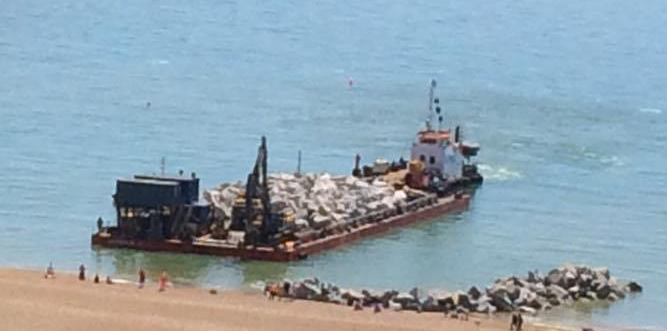Re-setting Hastings’ broken arm
More than 25,000 tonnes of granite will be dumped off Hastings beach over the next few weeks – all needed to make the final repairs to the harbour arm.
The first part of the reconstruction work took place last year with the landward part of the arm being rebuilt mostly from existing concrete which had fallen away and was lying on the seabed. Once replaced it was then refaced with 340 cubic metres of concrete. This summer, the rest of the work will take place, finally completing repairs to the entire harbour arm.
The arm was built in the 1890s, as the first part of a harbour that never happened, the company building it ran out of money. However, the harbour arm became important to protect the fishing beach and make it safer to launch boats during rough weather. Its existence also changed the shape of the beach; the effects of ‘longshore drift’, saw the accumulation of shingle on the western side, making the beach much deeper. Before the harbour arm was built the sea came up to what is now the A259 and Rock-a-Nore. So as well as improving sea defences, the harbour arm also allowed the creation of seafront attractions and Pelham Place car park.

Over the years the Harbour Arm has been damaged by storms and by the Luftwaffe during the war and according to some sources it was deliberately damaged by local people to discourage its possible use by German invasion forces during World War II. Now, thanks to a £3m Environment Agency grant, Hastings Borough Council is rebuilding it.
The granite is being supplied from a quarry in Cornwall and the barges delivering it make the journey along the coast, each load will contain between 2,000 and 5,000 tonnes.
Unloading takes place at high tide, with the barge coming in as close as possible. At low tide mobile cranes move in to lift the blocks into place. This is a more sophisticated process than it might appear, as placement is controlled by the driver directed by an on–board computer, like a giant, 3-D jigsaw puzzle. The gaps in the harbour arm will be filled, as well as constructing ‘shoulders’ to the rest of the arm, to help protect it.
This time the structure will not be faced with concrete because the uneven shape of the stacked granite blocks breaks up the force of the waves better, as well as giving a more natural appearance.
When the work is complete later in the summer, it will provide the protection from storms needed by our beach-launched fishing fleet for at least another hundred years.



